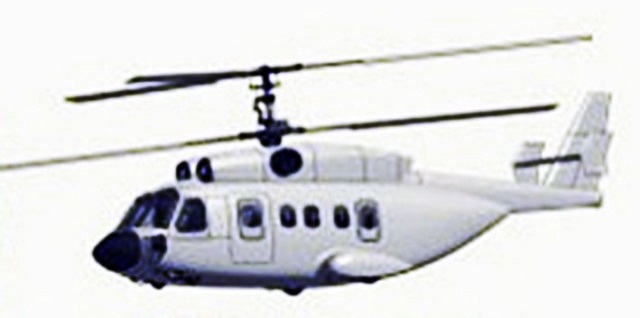New Russian Naval Helicopter Project Makes Progress
by Vladimir Karnozov
May 21, 2018, 6:01 AM

The Minoga configuration could be similar to this model of the Ka-92 high-speed helicopter that was displayed in 2007.
Russian Helicopters has provided an update on the next-generation naval helicopter project named Minoga. Company head Andrei Boginsky told journalists in Moscow that a mockup is being produced for inspection by the Russian Navy early next year. Russian Helicopters won an R&D contract from the Russian defense ministry in 2006 and has since conducted wind-tunnel testing. But Boginsky did not reveal many details of the proposed configuration.
Boginsky spoke shortly after the chief of the Russian navy fleet air arm, Gen. Igor Kozhin, said that work on the project is progressing well. He said, “The helicopter has been shaped and its main technical, economic, and operational performance targets set.” The maiden flight is planned for 2020.
The Minoga will be a fourth-generation of Russian naval deck helicopters, following the Kamov Ka-15, Ka-25, and Ka-27. They all featured coaxial main rotors, but although Kamov leads design work on the project, it is not yet clear whether the Minoga would keep this characteristic Kamov layout. Some sources suggest that the new helicopter design is based on the Ka-90/92 concept of the early 2000s, when Kamov competed with Mil to design a high-speed helicopter for the civilian market.
Boginsky did say that some findings made during the high-speed helicopter research programs are being applied to new designs for the military. “The company decided in 2015 to halt the work on the commercial helicopter because our studies indicated the price of speed was going to be too expensive for commercial operators,” he said.
The Minoga will be powered by a pair of Klimov TV7-117V turboshaft engines interchangeable with their predecessor VK-2500. This indicates that the new rotorcraft will be made larger when initially planned in 2015, when the NPO Saturn RD-600V was being considered. Weighing 380 kg (772 lb), the TV7-117V develops 3,500-3,750 hp in emergencies; 2,500-3,000 at maximum takeoff weight; and 1,650 hp during a typical cruise. However, the new naval helicopter must be compact enough for a pair of them to be stored in a standard ship hangar that is designed to house a single Ka-27. Kamov has previously studied a lightweight deck helicopter in the four-five metric-ton class. Later, the gross weight grew to some seven-eight metric tons, yet significantly under the figure for the long-serving Ka-27, which is 12 metric tons.
The primary role for the Minoga will be antisubmarine warfare, but unlike its predecessors, it will also be required to carry out other tasks. Of note, the Kamov Ka-52K Katran is already in flight tests, but its missions are limited to electronic reconnaissance and strike.
NPP Polet is reported to be heading the work on the Minoga’s mission equipment. Its parent organization Rostec says that the Russian navy is seeking “an intelligent command/control system." A life-long after-sales support commitment from the industry is another navy requirement.
Boginsky also mentioned the flying laboratory based on the Mi-24 attack helicopter. It is testing new engineering solutions for main rotor blades. Boginsky said that some good results had been obtained, and he urged the defense ministry to provide extra funding for R&D work on shaping next-generation combat rotorcraft.
https://www.ainonline.com/aviation-news/defense/2018-05-21/new-russian-naval-helicopter-project-makes-progress#












